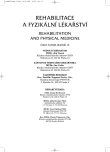Sole – an Important Part of Stabilisation System
Authors:
K. Lewit; M. Lepšíková
Authors‘ workplace:
Klinika rehabilitace a tělovýchovného lékařství 2. LF UK a FNM, Praha
Published in:
Rehabil. fyz. Lék., 15, 2008, No. 3, pp. 99-104.
Category:
Original Papers
Overview
Human upright posture is very unstable, particularly in the sagittal plane. The spinal column is held like a mast by chains of long muscles acting together like ropes. It consists, however, of 24 vertebrae which would buckle under the strain without the action of the short intervertebral muscles and the support given by the abdominal cavity and its walls. Analogically, the arch of the foot consists of 12 bones balancing the leg over the spherical talus. Disturbed function of the feet causes chain reactions throughout the entire motor system as does a dysfunction of the deep stabilisation system of the trunk manifesting itself as myofascial trigger points (TrPs) which restrict movement. There is a considerable interaction of both stabilisation systems.
Key words:
stabilisation system, upright posture, chain reactions, myofascial trigger points, co-contraction (co-activation)
Sources
1. Dejung, B.: Triggerpunkttherapie. Huber, Bern, 2004.
2. Gutmann, G., Véle, F.: Das aufrechte Stehen. Westdeutscher Verlag. Forschungsberichte des Landes Nordrhein-Westfalen, No 2796. Fachgruppe Medilzin, 1978.
3. Hermachová, H.: O kožním vnímání, jeho změnách a ovlivnění. Rehab. fyz. Lék., 8, 2001, 4, s. 182 -184.
4. Hides, J. A., Richardson, C.A., Jull, G., Davies, S. E.: Ultrasound imaging in rehabilitation. Austr. J. Physiother. Brisbain Australia, 41, 1995, s. 187-193.
5. Hodges, P. W., Richardson, C. A.: Insufficient stabilization of the lumbar spine associated with low back pain. A motor control evaluation of the transversus abdominis. Spine, 1996, s. 2640-2650.
6. Hufschmidt, H. J.: Propriozeptivität und Steuerung der Rückenmuskulatur. In: Wolff, H.D. (Hrsg.) Manuelle Medizin und ihre wissenschaftlichen Grundlagen. Physikal. Med., Heidelberg, 1970,s. 75-79.
7. Cholewicki, J., Panjabi, M. M., Chachaturian, A.: Stabilization function of the trunk flexor-extensor muscles around neutral posture. Spine, 22, 1997, s. 2207-2212.
8. Kolář, P.: Senzomotorická podstata posturálních funkcí jako základ pro nové přístupy ve fyzioterapii. Rehab. fyz. Lék., 5, 1998, 4, s. 5-13.
9. Kolář, P., Lewit, K.: Význam hlubokého stabilizačního systému v rámci vertebrogenních obtíží. Neurologie pro praxi. 6, 2005, s. 270-275.
10. Kolář, P.: Vertebrogenní obtíže a stabilizační funkce svalů – diagnostika. Rehab. fyz Lék., 13, 2006, 4, s. 155-170.
11. Kolář, P.: Vertebrogenní obtíže a stabilizační funkce páteře – terapie. Rehab. fyz. Lék., 14, 2007, 1, s. 3-17.
12. KORR, I. M.: Proprioceptors and somatic dysfunction. J. Amer. Osteop. Ass., 74, 1975, s. 638-650.
13. Lewit, K.: Některá zřetězení funkčních poruch ve světle vzorců na základě vývojové neurologie. Rehab. fyz. Lék., 5, 1998, 4, s. 147-151.
14. Lewit, K.: Stabilisierung der Wirbelsäule. Manuelle Therapie, 3, 1999, s. 117-120.
15. Panjabi, M. M.: The stabilization system of the spine, Part I. Function, dysfunction, adptation and enhancement. J. Spinal Disorders, 5, 1992, s. 383-390.
16. Panjabi, M. M.: The stabilization system of the spine. Part II. Neutral zone and instability hypothesis. J. Spinal Disorders, 5, 1992, s. 390-397.
17. Radebold, A. R., Cholewicki, J., Panjabi, M. M., Patel, T.: Muscle response patterns to sudden trunk loading in healthy individuals and patients with low back pain. Spine, 25, 2000, s. 947-954.
18. Richrdson, C. A., Hodges, P. W., Hides, J. A.: Therapeutic exercise for spinal stabilisation in low back pain. 2. vyd., Churchill Livingstone, 2004.
19. Simons, D. G.,Travell, J. G.: Myofascial trigger points, a possible explanation (Letters to the Editor). Pain, 10, 1981, s. 106-109.
20. Skládal, J., Ťkavran, K., Ruth, C., Mikulenka, V.: Posturální funkce bránice. Čs. Fyziol., 14, 1970, s. 279- 280.
21. Véle, F.: Osobní sdělení.
22. Vojta, V.: Mozkové poruchy v kojeneckém věku. Avicenum, Praha, 1993.
Labels
Physiotherapist, university degree Rehabilitation Sports medicineArticle was published in
Rehabilitation & Physical Medicine

2008 Issue 3
- Hope Awakens with Early Diagnosis of Parkinson's Disease Based on Skin Odor
- Deep stimulation of the globus pallidus improved clinical symptoms in a patient with refractory parkinsonism and genetic mutation
Most read in this issue
- Sole – an Important Part of Stabilisation System
- Complex Rehabilitation Care in Patients after Amputation of Lower Extremity
- Activation of Muscle Latissimus Dorsi in the Course of Locomotin of Uppper Limb
- Influencing Mechanosensitivity of Nervous Tissues by the Neural Mobilisation Method
